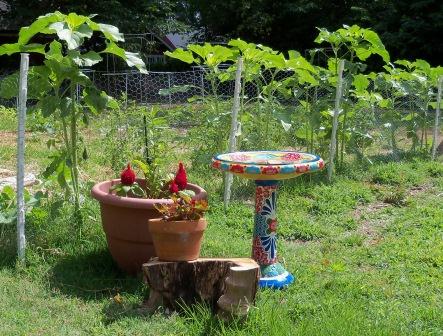By Tiffany Selvey, Master Gardener and mama of 1
I’ll never forget the first time I walked out to my garden to find one of my squash plants, that was healthy the day before, completely dead. I lifted one of the big leaves to get a view of what was going on and the whole plant, all the way down to the stem, came with it. I stood there stunned, with an entire 2-foot-wide squash plant in my hand! There are few things more discouraging to a new gardener than a plant that drops dead overnight.
Thankfully, there aren’t many pests that cause sudden death in a plant, and most pests can be taken care of when signs of damage appear. Those few pests that do cause major damage can, for the most part, be prevented. The good news is, these pests are best prevented without chemicals. We don’t want that yucky stuff in our soil OR on our plates.
Vine borers: These guys first appear in the garden as a moth that can be mistaken for a bee or wasp, with an orange body and black wings. They are seeking pollen, so watch any blooms near your squash (including yellow, zucchini) for them beginning in early June. Damage is caused by the borer laying her eggs in the stem of the squash plant, then the larvae eat their way out, destroying water and mineral flow to the plant. Vining squash such as acorn, butternut, pumpkin, and watermelon are far less likely to be infested than bush types such as yellow squash and zucchini, so planting those varieties is a great way to avoid the problem. Prevention in bush squash involves covering the stem of the plant with a toilet paper roll cut in half, wrapping it around the base stem of the plant, and taping it together.Then there’s no place for mother borer to lay her eggs! (Follow me at one of the links below to see an upcoming post on how this is done.)

Hornworm: The tomato and tobacco hornworm is actually a caterpillar, and either will decimate a tomato plant overnight by eating all its foliage. This fella is about 3-4” long with a large green or red “horn” (don’t worry, it’s fake!) on its back end. The best prevention for hornworms is to attract birds. They just love those big meaty caterpillars! I do a few things to attract birds, including planting sunflowers. Birds are great for the garden, and don’t worry if they flock in because they won’t damage your plants. They may steal a few worms, but there are enough to go around. While there, they will eat bad grubs, Japanese beetles, and our enemy, the hornworm. Be sure they have a place to drink and bathe near the garden by placing a bird bath nearby.
Cutworm: With the ability to cut the stem of a plant overnight, cutworms are probably the the fastest killer on our list. While feeding on your tomatoes, corn, and other plants, they wrap themselves around the stem and eat it, cutting it in half. Around here, they mostly affect tomatoes and can be prevented by wrapping the stem, much like preventing squash borers. For small seedlings a plastic straw can be wrapped around the stem, for larger tomato plants, a toilet paper roll can be used. Other options include toothpicks, Dixie cups, and aluminum foil. The idea is to protect the stem of the plant at and right below the soil line, where they feed.
Now you know what to do to keep worms and borers at bay and away from your homegrown fruits and veggies. Happy pest-free gardening!
Tiffany Se lvey is a Master Gardener who writes about her passion for growing, cooking, and living naturally at www.20-by-20.com. When she’s not elbow deep in soil, she enjoys raising a very active son, laughing with her husband, and wrangling their five pets. Click HERE to read more in our Gardening Category.
lvey is a Master Gardener who writes about her passion for growing, cooking, and living naturally at www.20-by-20.com. When she’s not elbow deep in soil, she enjoys raising a very active son, laughing with her husband, and wrangling their five pets. Click HERE to read more in our Gardening Category.
